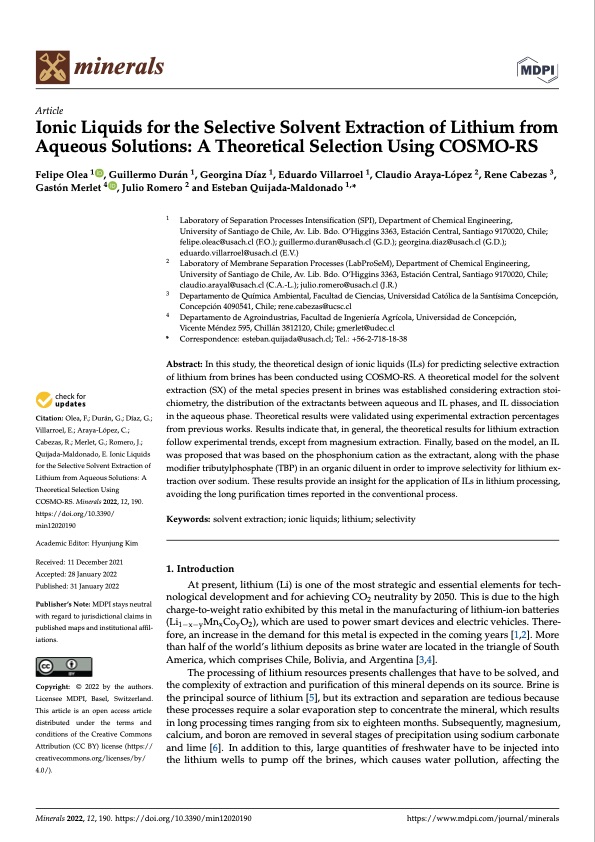
PDF Publication Title:
Text from PDF Page: 001
minerals Article Ionic Liquids for the Selective Solvent Extraction of Lithium from Aqueous Solutions: A Theoretical Selection Using COSMO-RS Felipe Olea 1 , Guillermo Durán 1, Georgina Díaz 1, Eduardo Villarroel 1, Claudio Araya-López 2, Rene Cabezas 3, Gastón Merlet 4 , Julio Romero 2 and Esteban Quijada-Maldonado 1,* Citation: Olea, F.; Durán, G.; Díaz, G.; Villarroel, E.; Araya-López, C.; Cabezas, R.; Merlet, G.; Romero, J.; Quijada-Maldonado, E. Ionic Liquids for the Selective Solvent Extraction of Lithium from Aqueous Solutions: A Theoretical Selection Using COSMO-RS. Minerals 2022, 12, 190. https://doi.org/10.3390/ min12020190 Academic Editor: Hyunjung Kim Received: 11 December 2021 Accepted: 28 January 2022 Published: 31 January 2022 Publisher’s Note: MDPI stays neutral with regard to jurisdictional claims in published maps and institutional affil- iations. Copyright: © 2022 by the authors. Licensee MDPI, Basel, Switzerland. This article is an open access article distributed under the terms and conditions of the Creative Commons Attribution (CC BY) license (https:// creativecommons.org/licenses/by/ 4.0/). 1 2 3 4 * Correspondence: esteban.quijada@usach.cl; Tel.: +56-2-718-18-38 Abstract: In this study, the theoretical design of ionic liquids (ILs) for predicting selective extraction of lithium from brines has been conducted using COSMO-RS. A theoretical model for the solvent extraction (SX) of the metal species present in brines was established considering extraction stoi- chiometry, the distribution of the extractants between aqueous and IL phases, and IL dissociation in the aqueous phase. Theoretical results were validated using experimental extraction percentages from previous works. Results indicate that, in general, the theoretical results for lithium extraction follow experimental trends, except from magnesium extraction. Finally, based on the model, an IL was proposed that was based on the phosphonium cation as the extractant, along with the phase modifier tributylphosphate (TBP) in an organic diluent in order to improve selectivity for lithium ex- traction over sodium. These results provide an insight for the application of ILs in lithium processing, avoiding the long purification times reported in the conventional process. Keywords: solvent extraction; ionic liquids; lithium; selectivity 1. Introduction At present, lithium (Li) is one of the most strategic and essential elements for tech- nological development and for achieving CO2 neutrality by 2050. This is due to the high charge-to-weight ratio exhibited by this metal in the manufacturing of lithium-ion batteries (Li1−x−yMnxCoyO2), which are used to power smart devices and electric vehicles. There- fore, an increase in the demand for this metal is expected in the coming years [1,2]. More than half of the world’s lithium deposits as brine water are located in the triangle of South America, which comprises Chile, Bolivia, and Argentina [3,4]. The processing of lithium resources presents challenges that have to be solved, and the complexity of extraction and purification of this mineral depends on its source. Brine is the principal source of lithium [5], but its extraction and separation are tedious because these processes require a solar evaporation step to concentrate the mineral, which results in long processing times ranging from six to eighteen months. Subsequently, magnesium, calcium, and boron are removed in several stages of precipitation using sodium carbonate and lime [6]. In addition to this, large quantities of freshwater have to be injected into the lithium wells to pump off the brines, which causes water pollution, affecting the Laboratory of Separation Processes Intensification (SPI), Department of Chemical Engineering, University of Santiago de Chile, Av. Lib. Bdo. O’Higgins 3363, Estación Central, Santiago 9170020, Chile; felipe.oleac@usach.cl (F.O.); guillermo.duran@usach.cl (G.D.); georgina.diaz@usach.cl (G.D.); eduardo.villarroel@usach.cl (E.V.) Laboratory of Membrane Separation Processes (LabProSeM), Department of Chemical Engineering, University of Santiago de Chile, Av. Lib. Bdo. O’Higgins 3363, Estación Central, Santiago 9170020, Chile; claudio.arayal@usach.cl (C.A.-L.); julio.romero@usach.cl (J.R.) Departamento de Química Ambiental, Facultad de Ciencias, Universidad Católica de la Santísima Concepción, Concepción 4090541, Chile; rene.cabezas@ucsc.cl Departamento de Agroindustrias, Facultad de Ingeniería Agrícola, Universidad de Concepción, Vicente Méndez 595, Chillán 3812120, Chile; gmerlet@udec.cl Minerals 2022, 12, 190. https://doi.org/10.3390/min12020190 https://www.mdpi.com/journal/mineralsPDF Image | Ionic Liquids for the Selective Solvent Extraction of Lithium

PDF Search Title:
Ionic Liquids for the Selective Solvent Extraction of LithiumOriginal File Name Searched:
minerals-12-00190-v3.pdfDIY PDF Search: Google It | Yahoo | Bing
Product and Development Focus for Infinity Turbine
ORC Waste Heat Turbine and ORC System Build Plans: All turbine plans are $10,000 each. This allows you to build a system and then consider licensing for production after you have completed and tested a unit.Redox Flow Battery Technology: With the advent of the new USA tax credits for producing and selling batteries ($35/kW) we are focussing on a simple flow battery using shipping containers as the modular electrolyte storage units with tax credits up to $140,000 per system. Our main focus is on the salt battery. This battery can be used for both thermal and electrical storage applications. We call it the Cogeneration Battery or Cogen Battery. One project is converting salt (brine) based water conditioners to simultaneously produce power. In addition, there are many opportunities to extract Lithium from brine (salt lakes, groundwater, and producer water).Salt water or brine are huge sources for lithium. Most of the worlds lithium is acquired from a brine source. It's even in seawater in a low concentration. Brine is also a byproduct of huge powerplants, which can now use that as an electrolyte and a huge flow battery (which allows storage at the source).We welcome any business and equipment inquiries, as well as licensing our turbines for manufacturing.| CONTACT TEL: 608-238-6001 Email: greg@infinityturbine.com | RSS | AMP |